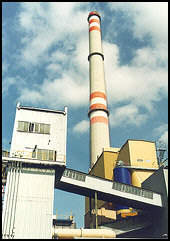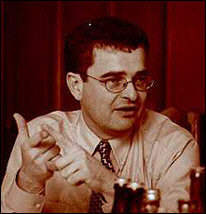 Privatization process Privatization process |

All post-communist countries faced a major question - how to privatize their industries, quickly and effectively. This was a task so far unheard of. Even though western economies privatized from time to time, it always was one or a few companies only, with a lot of time for public debate and the investors having a history of the privatized company to look at. However, there have been thousands of companies being put on the auction block simultaneously across the region, with no previous experience in the free-market operations.
The government of Vaclav Klaus came up with an idea in 1990, at that time applauded by most international organizations - the so-called coupon privatization. Citizens that wanted to participate were issued coupons they could invest in several hundred companies or entrust them to investment funds. The lottery seemed to be appealing, as it was giving everybody a chance to win, turning Czechs into a nation of shareholders. However, coupon-privatized companies received nothing of the most needed ingredients for the success in the free market and international competition - new capital, know-how and responsible owners. Unless investment funds acquired large stakes in the privatized companies, the managements were left on their own, without any control from the company's owners.
The two waves of coupon privatization brought also another effect - the creation of the Prague Stock Exchange and an electronic market set up primarily for individuals' trading, the RM-System. While the theory seemed to be great - start up the stock exchange with thousands of companies listed on day one - it backfired badly. Unlike elsewhere, companies did not come to the stock exchange for new capital, but were mandated to do so by a law. Therefore, except for a very few companies that are actively traded today in the spot trading system, the stock exchange was only used to amass majority stakes in the companies. The majority stakes were then sold, often by the investment funds, to international companies looking to enter the Czech market. The profit that might have been the state's has thus ended in the investment funds or - very often - siphoned off to various tax heavens by individuals taking advantage of inadequate legislation and missing control.
However, 1998 has brought a reversal in the trend. The Securities and Exchange Commission was finally established (the previous stock market watchdog, a part of the ministry of finance, had not only very limited powers but was also staffed by incompetent people) and quickly rid the market off the worst offenders through a tough relicensing process of all investment companies, brokerages and individual brokers. It has also increased the pressure on publicly traded companies to disclose financial information on a timely basis to increase the credibility of the market and improved the stock exchange's trading system.
Despite the improvements, liquidity remains low
- but there is hope. The Czech Republic has already
seen an explosive growth of interest in foreign
(especially US) stocks, which has opened new possibilities
for brokers and asset managers, some of which (for
example Private Investors) even started offering
online trading on the US markets for retail clients.
Prague Stock Exchange should profit from the growing
interest too, as more Czechs learn to trust stock
investing, as international investors look for new
opportunities and the Prague Stock Exchange becomes
more integrated into the European network. In mid-May,
the Prague Stock Exchange signed a memorandum of
cooperation with the London Stock Exchange, that
should first encourage top Czech companies to cross-list
their shares in London (currently, there are four
Czech companies listed in London - two leading telecoms,
Cesky Telecom and Ceske radiokomunikace, and two
of the largest three banks, Ceska sporitelna and
Komercni banka), improve disclosure requirements
and market surveillance. Later, the memorandum should
pave way for integration of the Prague Stock Exchange
into the developing European-wide web of stock exchanges. |
The industrial sector also seems to be improving. The aforementioned credit crunch in 1998 - 1999 forced many companies to restructure their operations, search for foreign partners and brought even a few bankruptcies of large industrial conglomerates. While the importance of private owners is generally well known, the Czech Republic can offer several case studies to look at. One of the best ones is in the Northern Moravian region, known for its steel making, heavy industry and black coal production. With demand dropping heavily in all of these areas, the three regional steel mills - Nova Hut, Trinecke zelezarny and Vitkovice - were put under heavy pressure. Trinecke zelezarny, the smallest of the three, was put for sale, while the other two underwent another of Vaclav Klaus' experiments - management privatization. Under this scheme, managements were sold 1% of the company and if they passed several tests - restructuring, layoffs and stock price growth - they would be sold another 10 - 15 % of the company. While it might have worked in other industries, the recession-hit steelmakers got into deep trouble as managers were pressured to meet deadlines, disregarding other factors that any other managers or owners would have to factor in.

"One of the main differences between us and the other two steel mills in the Northern Moravian region is the fact that we are a fully private company and that we have taken a number of steps to restructure the business of Trinecke zelezarny immediately after the privatization process was complete," explains Oskar Sotak, chairman of the board and managing director of Moravia Steel which holds the controlling stake in Trinecke zelezarny. The main tasks for the new owners were to cut costs (and keep effective cost control in place), break the spell of waiting for the government help, focus on increasing the steel mill's efficiency and productivity and create a more aggressive commercial strategy. Sotak also points out that a part of the success is based on being careful and not expand recklessly, as many other Czech managers did. "Rather than expanding, we want to strengthen the ties with our customers to be able to increase our added value and diminish the volatility of prices," he says.
The poor state of the Czech steel industry opens up many new opportunities to successful local firms such as Moravia Steel and their partners. Sotak's company for example looks for business partners that would invest in the finishing level of Trinecke zelezarny's products. "A number of our customers are bankrupt and I am actively looking for partners to join us in taking over and operating them," he says, explaining that since Trinecke zelezarny can supply high-quality steel products and there is expected growth of demand, especially from automotive industry, vertical integration can offer his company a great market opportunity.
If Sotak finds partners he is looking for, the acquired companies will be added to a growing list of small and medium-sized companies that now have foreign owners or strategic partners and that are driving the renewed growth of the Czech economy. Besides that, even some of the large behemoths seem to get another try, mostly due to the Revitalization Agency, a new government-sponsored institution responsible for turning ailing industrial complexes around and selling them off to new owners. Even though state-funded, the Revitalization Agency is managed by independent international advisors of the Latona-Lazards consortium, thus limiting the possible state interference into the often hurting restructuring process (for more on the activities of the Revitalization Agency and its parent company see the following chapter). |

